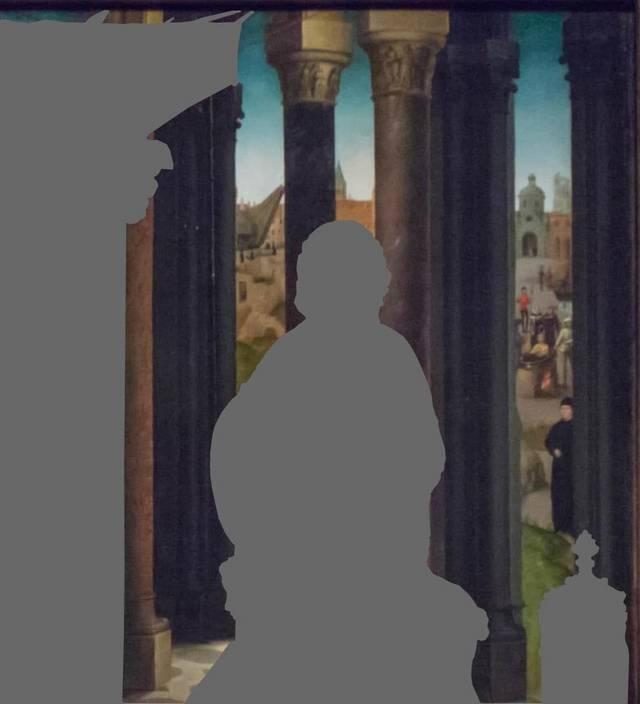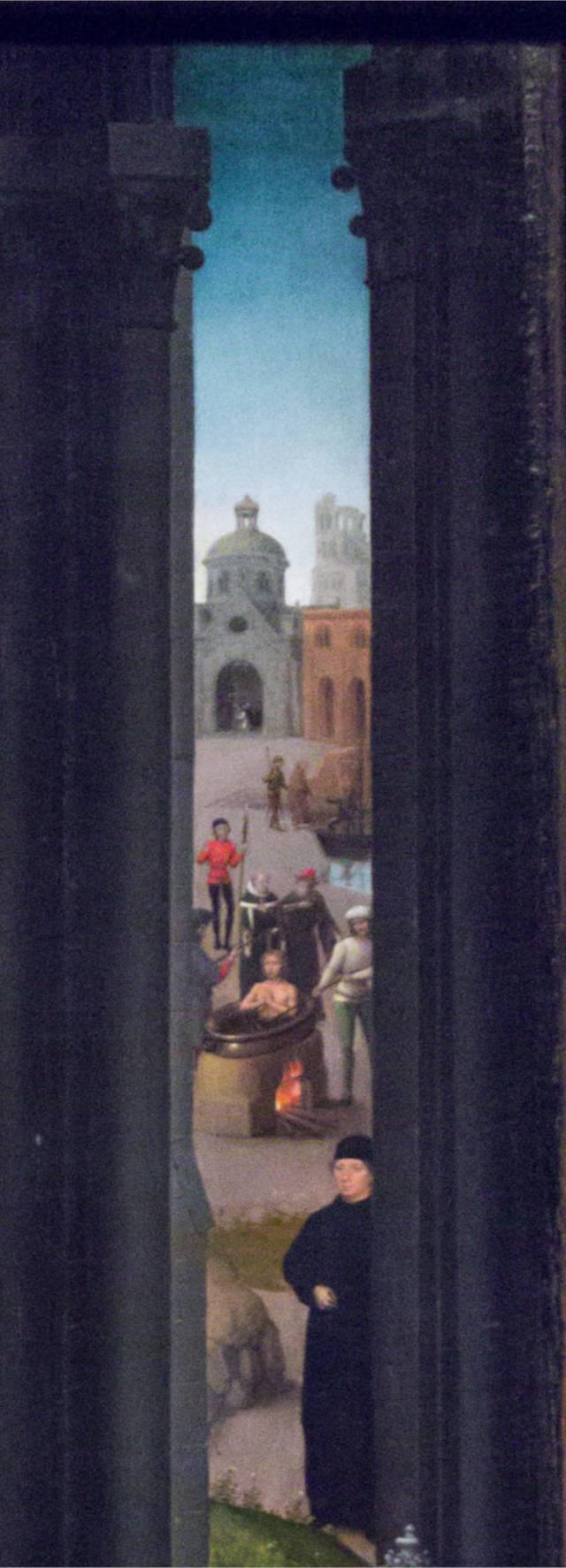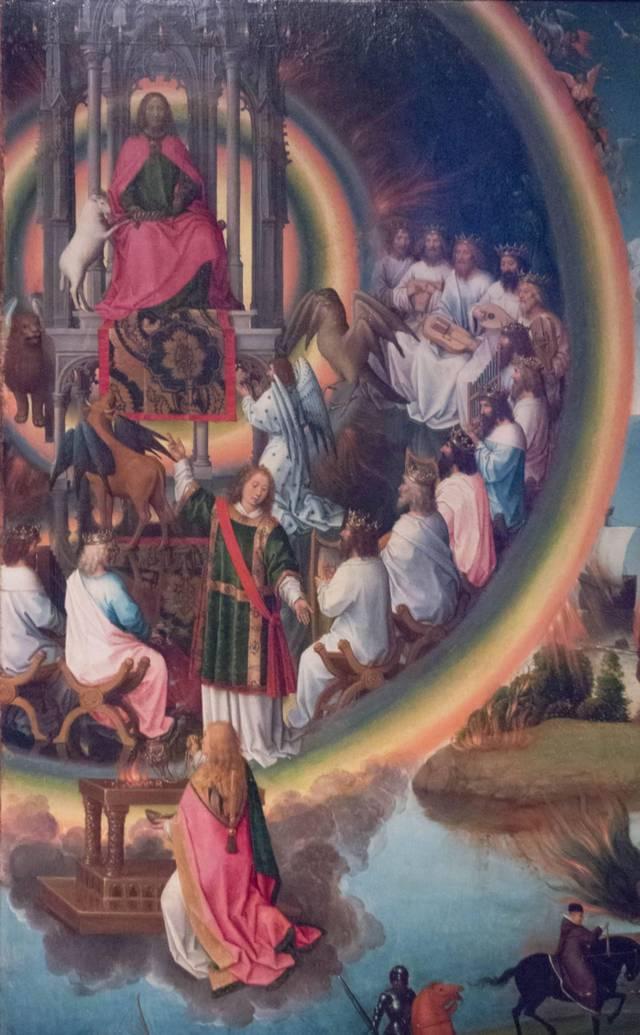scenes from the legend of John the Evangelist according to The Golden Legend and The Revelation
details on John the Evangelist according to The Golden Legend and The Book of Revelation
On the central panel in the upper part on the right of the background appear some scenes of the legend of John the Evangelist.

details on John the Evangelist according to The Golden Legend and The Revelation
Unlike John the Baptist, historically there is no historical document other than those of the Christian faith.
According to these documents and modern specialists, John the Evangelist can designate:
- John the «Apostle» who appears in the gospels of Mark, Luke, Matthew and the Acts of the Apostles,
- the disciple whom Jesus loved to write the gospel called «of John»,
- John «of Patmos» writer of the text of The Revelation.
We summarize the differences that distinguish these characters below.
John the “Apostle”
John «the Apostle» is one of the two «sons of Zebedee» (Mark chapter 3 verses 16 to 19, Matthew chapter 10 verses 2 to 5 and Luke chapter 6 verses 13 to 16).
- His brother is James, known as «the Greater».
- Jesus called them the «sons of thunder» (Mark chapter 3 verse 17).
- Like his brother and two other apostles, Simon Peter and Andrew, he is one of the fishermen of Lake Tiberias who abandoned his nets to follow Jesus.
- From there, he witnessed:
- the transfiguration of Jesus (Mark chapter 9 verse 2, Matthew chapter 17 verse 1 and Luke chapter 9 verse 28),
- the healing of Simon Peter's mother-in-law (Mark chapter 1 verse 29),
- the healing of Jairus' daughter the ruler of the synagogue (Mark chapter 5 verse 37 and Luke chapter 8 verse 51),
- was present with his brother when Jesus was tempted to renounce in the Garden of Gethsemane (Mark chapter 13 verse 3), but he fell asleep (Mark chapter 14 verse 33).
the disciple whom jesus loved
-
The disciple whom Jesus loved appears at the end of the gospel called «of John» (John chapter 21 verse 20; verses 24 to 25):
“Then Peter, turning around, saw a disciple following. This was the disciple whom Jesus sincerely loved.”
(…)
“This is the disciple who testifies about these things, and wrote these things.”
There is nothing in the text that allows us to call him «John», so the designation “Gospel of John” cannot be right: it should be the “Gospel of the disciple whom Jesus loved”.
He is quite an extraordinary character: he is a disciple of Jesus among others with whom every reader can identify, he is loved by Jesus himself and therefore finds himself closer to him than anyone else.
He does not hesitate, just after the previous excerpt, to give his opinion (John chapter 21 verse 25):
“There are also many other things which Jesus did, which if they would all be written, I suppose that even the world itself wouldn't have room for the books that would be written.”
-
Jesus himself, on the occasion of a question from Peter, expresses a wish for his destiny at the Last Supper (John chapter 21 verses 21 to 23):
Peter seeing this disciple, said to Jesus,
“Lord, what about this man?”
Jesus said to him,
“If I desire that he stay until I come, what is that to you?”
-
It is also him who
had also leaned on Jesus' breast
, he asks him who will betray him (John chapter 13 verses 25). -
At the crucifixion, Jesus entrusted his own mother to him, saying (John chapter 19 verses 26 to 27):
“Woman, behold your son!”,
Then he said to the disciple,
“Behold your mother!”.
-
When Mary Magdalene discovered the empty tomb, she ran to tell the «beloved disciple» and Peter; he was the first to reach the tomb (John chapter 20 verses 2 to 8).
-
He was the first to recognize Jesus at Lake Tiberias after his resurrection (John chapter 21 verse 7).
john of patmos
John of Patmos appears at the beginning of the text of The Revelation which presents him as (The Revelation chapter 1 verses 1 to 9):
a
servant
to whom god (…)sent and made known by his angel
(…)the things which must happen soon
(…)to the seven churches in Asia Minor
.
john the evangelist in relation to The Golden Legend
The representation of John the Evangelist broadly follows the account established by Jacobus da Varagine in Chapters 9 and 65 of The Golden Legend.
- read: text of the Legend of John the Baptist from chapter 9 of The Golden Legend,
- read: text of the Legend of John the Evangelist before the Latin Gate from chapter 65 of The Golden Legend.
john the evangelist scalded by order of emperor domitian in front of the latin gate in rome and departure for exile in the island of patmos
The narrative starts on the central panel (chapter 65):
- «John was preaching at Ephesus when he was arrested by the proconsul and invited to sacrifice to the gods.
- As he refused, he was thrown into prison; a letter was then sent to the Emperor Domitian designating him as a sacrilegious magician, contender of the gods and worshipper of the Crucified.
- By order of Domitian, John was then taken to Rome where, after having derisively cut his hair, in front of the gate of the city called «Latin», he was flogged and thrown into a cauldron of boiling oil under which a fiery fire was burning».

- «But John felt no pain and came out completely unscathed, not burnt but anointed. In this view, Domitian was stunned and feared to put him to death. So, in this place, Christians have built a church, and today is solemnly celebrated as that of John's martyrdom.».
The representation of Memling shows on the horizon on the left, this church, on the right, the Colosseum of Rome and the Latin Gate.
- «The emperor, realizing that he was not renouncing preaching, exiled him to the island of Patmos», (the departure for Patmos appears in the middle: some men board a boat) «where, in solitude, he wrote The Revelation» (chapter 9).
Overview of the right inner shutter: John bears witness to The Revelation in Patmos.
The right inner shutter is entirely dedicated to the visions John had in Patmos note 9 .
Memling's representation is particularly noteworthy because while there are many representations of The Revelation as a succession of paintings, in contrast there are very few that assume a unity of the space of representation.
And for good reason: the narrative of John of Patmos presents a remarkable complexity.
And yet Memling succeeds in the tour-de-force of making the space of representation as credible, supernaturally complex as the narrative.

Immediately I was in the Spirit. Behold, there was a throne set in heaven(…) Before the throne was something like a sea of glass, similar to crystal», The Revelation, excerpts of chapters 4 to 12.
Memling represents the apostle, sitting on a circular rock, the island of Patmos in the middle of the Aegean Sea.
He holds a feather and a penknife in his hand, and on his knees one can see a notebook.
John is represented when he has not yet even begun to write, in the blink of an eye, at the very moment when he is seized by the «Apocalypse», which in ancient Greek means «unveiling» and has been translated into «revelation».
these visions appear above him in the sky, on the water and on the nearby land on all the rest of the shutter.
We choose to follow John's own way to tell the unveiling in the text (The Revelation chapter 4 verse 2 and verse 6), which begins at the top left of the shutter: this way it is possible to compare the text with Memling's representation of it.
Vision of the throne of god, the heavenly court and the lamb - The Revelation, chapters 4 verse 2 to chapter 6 verse 1
chapter 4
- Immediately I was in the Spirit. Behold, there was a throne set in heaven, and one sitting on the throne
- that looked like a jasper stone and a sardius. There was a rainbow around the throne, like an emerald to look at.
- Around the throne were twenty-four thrones. On the thrones were twenty-four elders sitting, dressed in white garments, with crowns of gold on their heads.
- Out of the throne proceed lightnings, sounds, and thunders. There were seven lamps of fire burning before his throne, which are the seven Spirits of God.
- Before the throne was something like a sea of glass, similar to crystal. In the midst of the throne, and around the throne were four living creatures full of eyes before and behind.»

There was a rainbow around the throne(…)
the four living creatures(…)
a book written inside and outside, sealed shut with seven seals(…)
the elders, The Revelation, chapter 4 verses 2 to 8, chapter 5 verse 1, 6 to 7.
- The first creature was like a lion, and the second creature like a calf, and the third creature had a face like a man, and the fourth was like a flying eagle.
The four living creatures, each one of them having six wings, are full of eyes around and within. They have no rest day and night, saying,
“Holy, holy, holy is the Lord God, the Almighty, who was and who is and who is to come!”.
chapter 5
- I saw, in the right hand of him who sat on the throne, a book written inside and outside, sealed shut with seven seals.
- I saw in the midst of the throne and of the four living creatures, and in the midst of the elders, a Lamb standing, as though it had been slain, having seven horns, and seven eyes, which are the seven Spirits of God, sent out into all the earth.
- Then he came, and he took it out of the right hand of him who sat on the throne.